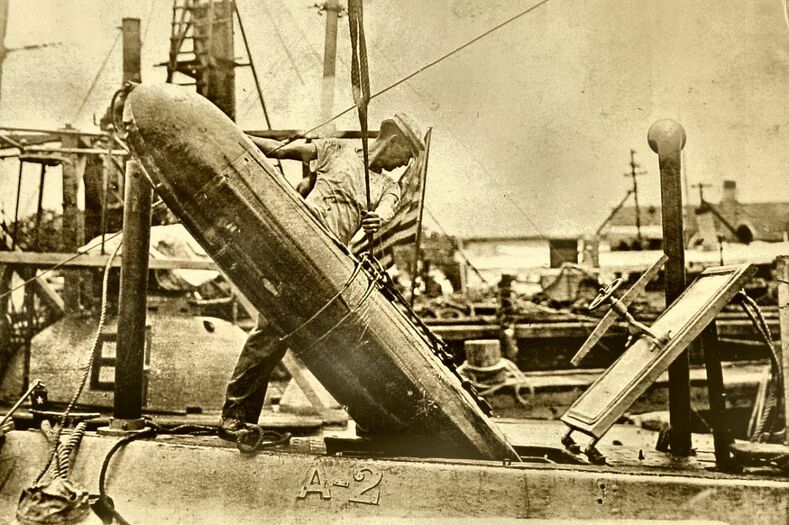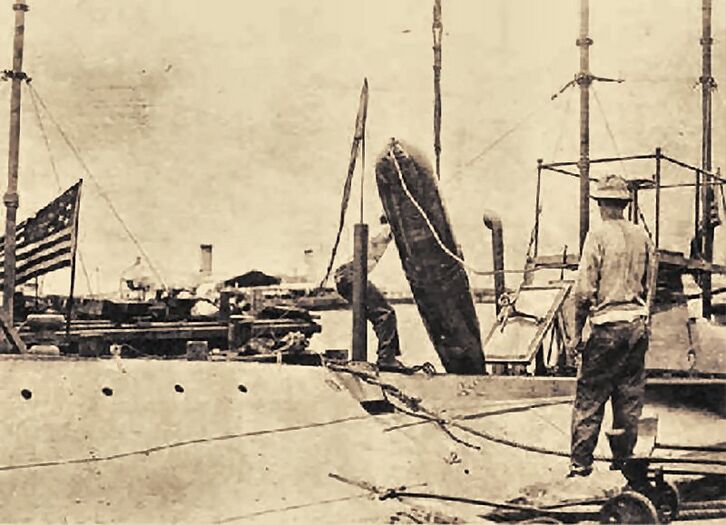Torpedo photos & information: Difference between revisions
Pbcjohnston (talk | contribs) →Bliss-Leavitt Mk 7: added Mk 7 photo |
Pbcjohnston (talk | contribs) →Westinghouse Mark 18 Mod 1 & Mod 2: Updated Navsource links |
||
| (36 intermediate revisions by the same user not shown) | |||
| Line 1: | Line 1: | ||
[[File: | [[File:New Header 1 Torpedo.jpg]] | ||
=== <big>Whitehead | === <big>Whitehead Mark 2 & Mark 3</big> === | ||
<div style="text-align: justify;"><span style="color:#00008B">The Whitehead Mk 2 and Mk 3 weapons were actually a surface ship design adapted later for submarine use. They were powered by a three-cylinder radial engine run on compressed air. They were so similar in configuration that it was hard to tell them apart. Indeed, they had the exact same operational parameters. However, the big difference is that the Mk3 was the first USN torpedo to use a gyroscope for azimuth control. This reduced deviation from left or right of planned track from 24 yards to just 8 yards. That is still a big margin, but in those early days it was quite impressive accuracy. | <div style="text-align: justify;"><span style="color:#00008B">The Whitehead Mk 2 and Mk 3 weapons were actually a surface ship design adapted later for submarine use. They were powered by a three-cylinder radial engine run on compressed air. They were so similar in configuration that it was hard to tell them apart. Indeed, they had the exact same operational parameters. However, the big difference is that the Mk3 was the first USN torpedo to use a gyroscope for azimuth control. This reduced deviation from left or right of planned track from 24 yards to just 8 yards. That is still a big margin, but in those early days it was quite impressive accuracy. | ||
| Line 7: | Line 7: | ||
[[File:A-class Torpedoes at Cavite.jpg|left|500px]] | [[File:A-class Torpedoes at Cavite.jpg|left|500px]] | ||
Whitehead Mk 3 torpedoes stored at the weapons depot at Naval Station Cavite, Philippines, approximately | Whitehead Mk 3 torpedoes stored at the weapons depot at Naval Station Cavite, Philippines, approximately 1910-1911. The wheeled carts allowed the quick movement of the weapons from storage to the pier. Note the newer Whitehead or Bliss Mk 5, 6, or 7 torpedoes in the racks in the upper right. | ||
<small>Photo in the private collection of Ric Hedman.</small> | <small>Photo in the private collection of Ric Hedman.</small> | ||
| Line 25: | Line 25: | ||
<div style="text-align: justify;"><span style="color:#000000"> | <div style="text-align: justify;"><span style="color:#000000"> | ||
=== <big>Bliss-Leavitt | === <big>Bliss-Leavitt Mark 4 Mod 1</big> === | ||
<div style="text-align: justify;"><span style="color:#00008B">The Bliss-Leavitt Mk 4 was the first torpedo specifically designed for submarine use. The surface navy had begun the transition to larger 21" diameter torps, but they would not fit in the restricted spaces of the submarines of the time, thus the BL Mk | <div style="text-align: justify;"><span style="color:#00008B">The Bliss-Leavitt Mk 4 was the first torpedo specifically designed for submarine use. The surface navy had begun the transition to larger 21" diameter torps, but they would not fit in the restricted spaces of the submarines of the time, thus the BL Mk 4 was scaled down to 17.7" for submarine use. It was 57 inches longer than the Mk 3, enabling a larger air flask that stored air at a much higher pressure. The propulsion system was vastly different from the earlier Whitehead weapons in that the Mk 4 used a vertical turbine spun by compressed air from the flask heated by an alcohol burner. The heated air gave it more energy and when combined with the turbine it increased the speed and range of the weapon. | ||
[[File:D-3 loading torp closeup.jpg|left|500px]] | [[File:D-3 loading torp closeup.jpg|left|500px]] | ||
D-3 hoisting aboard a Mk 4 torpedo that it as just recovered from a practice shot, circa 1912. This photo gives a good view of the aft end of the weapon, including the control surfaces and the twin contra-rotating propellers. The twin propellers spinning in opposite directions eliminated roll torque, preventing the weapon from cork-screwing along its longitudinal axis. Eliminating the roll torque also allowed the gyro to maintain a more accurate course. | D-3 hoisting aboard a Mk 4 torpedo that it as just recovered from a practice shot, circa 1912. This photo gives a good view of the aft end of the weapon, including the control surfaces and the twin contra-rotating propellers. The twin axially mounted propellers spinning in opposite directions eliminated roll torque, preventing the weapon from cork-screwing along its longitudinal axis. Eliminating the roll torque also allowed the gyro to maintain a more accurate course. Note the two very small rudders mounted in cutouts in the upper and lower skeg. The depth control planes were larger but mounted in a similar fashion. The rudder and planes skegs continue aft and form a '''+''' shaped guard around the propellers that is attached to the very aft end of the weapon. This was done out of concern that the torpedo's aft end may strike the edge of the tube while exiting and damage the control surfaces and the props. | ||
<small>U.S. Navy photo.</small> | |||
[[File:Red bar sub.jpg]] | [[File:Red bar sub.jpg]] | ||
| Line 38: | Line 40: | ||
[[File:D-3 loading torp 3.jpg|left|500px]] | [[File:D-3 loading torp 3.jpg|left|500px]] | ||
Another view of the operation shown above. There is a snubbing line attached to the aft end of the weapon, looped around the #1 periscope. This line allowed the weapon to be ''gently and carefully'' lowered into the torpedo room. | Another view of the operation shown above. There is a snubbing line attached to the aft end of the weapon, looped around the #1 periscope. This line allowed the weapon to be ''gently and carefully'' lowered into the torpedo room. | ||
<small>U.S. Navy photo.</small> | |||
[[File:Red bar sub.jpg]] | [[File:Red bar sub.jpg]] | ||
| Line 43: | Line 47: | ||
<div style="text-align: justify;"><span style="color:#000000"> | <div style="text-align: justify;"><span style="color:#000000"> | ||
=== <big>Bliss-Leavitt | === <big>Bliss-Leavitt Mark 6</big> === | ||
<div style="text-align: justify;"><span style="color:#00008B">Mostly a cruiser/destroyer torpedo, the Mk 6 was used briefly by E through H-class submarines until the more capable Mk 7 came along. In overall external appearance the Mk 6 was quite similar to the Mk 7. The Mk 6 introduced a horizontal turbine arrangement for the engine, one that would become standard for all subsequent torpedo engine designs. It was also the first Bliss-Leavitt design to | <div style="text-align: justify;"><span style="color:#00008B">Mostly a cruiser/destroyer torpedo, the Mk 6 was used briefly by E through H-class submarines until the more capable Mk 7 came along. In overall external appearance the Mk 6 was quite similar to the Mk 7. The Mk 6 introduced a horizontal turbine arrangement for the engine, one that would become standard for all subsequent torpedo engine designs. It was also the first Bliss-Leavitt design to eliminate the '''+''' shaped guard around the rudders and depth control planes. The rudders were also of an improved and simplified design. This would become a standard feature on all subsequent USN designs. Sources indicate that only about 100 of these weapons were produced. | ||
Currently, PigBoats.COM does not have a good picture of a Mk 6. An idea for its appearance can be gained from the Mk 7 pictures below. | Currently, PigBoats.COM does not have a good picture of a Mk 6. An idea for its appearance can be gained from the Mk 7 pictures below. | ||
| Line 53: | Line 57: | ||
<div style="text-align: justify;"><span style="color:#000000"> | <div style="text-align: justify;"><span style="color:#000000"> | ||
=== <big>Bliss-Leavitt | === <big>Bliss-Leavitt Mark 7</big> === | ||
<div style="text-align: justify;"><span style="color:#00008B">The Mk 7 torpedo introduced the "wet-heater" steam engine. This feature added a jet of seawater that was injected into the heated air stream, producing steam. With steam having much greater energy than simple heated air, the torpedo engine had more power and more range. The disadvantage is that it left a bubbly wake behind the | <div style="text-align: justify;"><span style="color:#00008B">The Mk 7 torpedo introduced the "wet-heater" steam engine. This feature added a jet of seawater that was injected into the heated air stream, producing steam. With steam having much greater energy than simple heated air, the torpedo engine had more power and more range. The disadvantage is that it left a bubbly wake behind the weapon as it traveled through the water, potentially alerting the enemy to its presence. Despite this, the wet-heater type engine became the standard for USN torpedoes until the introduction of the Mk 18 electric in 1943. | ||
In 1922 the Navy undertook a purge of older torpedoes in an effort to simplify the supply chain and ease training issues. All torpedoes prior to the Mk 7 were recalled and removed from service. As we moved towards WWII the Mk 7 was showing its age, but it was retained so that the Navy could equip the old O-class boats that were being brought out of reserve to train new submarine crews. It was the last 18" torpedo used by the Navy. | In 1922 the Navy undertook a purge of older torpedoes in an effort to simplify the supply chain and ease training issues. All torpedoes prior to the Mk 7 were recalled and removed from service. As we moved towards WWII the Mk 7 was showing its age, but it was retained so that the Navy could equip the old [[O-class|'''O-class boats''']] that were being brought out of reserve to train new submarine crews. It was the last 18" torpedo used by the Navy. | ||
Bliss produced four additional versions of the Mk 7 for use as aircraft dropped torpedoes. These were pulled out of service when the new Mk 13 was introduced in 1938. | Bliss produced four additional versions of the Mk 7 for use as aircraft dropped torpedoes. These were pulled out of service when the new Mk 13 was introduced in 1938. | ||
[[File:Bliss-Leavitt Mark 7 torpedo.tif.jpg|left|500px]] | [[File:Bliss-Leavitt Mark 7 torpedo.tif.jpg|left|500px]] | ||
A Mk 7 torpedo on a cart at NTS Newport, August 1913. Overall, it was virtually identical to the Mk 6 in appearance, but it was equipped the the more powerful wet-heater engine. Note the control surfaces forward of the twin contra-rotating propellers. It was a good weapon, but was considered to have an underpowered warhead at only 205 lbs of TNT. | A Mk 7 torpedo on a cart at NTS Newport, August 1913. Overall, it was virtually identical to the Mk 6 in appearance, but it was equipped the the more powerful wet-heater engine. Note the control surfaces forward of the twin contra-rotating propellers. It was a good weapon, but was considered to have an underpowered warhead at only 205 lbs of TNT. | ||
<small>Photo courtesy of the NHHC.</small> | <small>Photo courtesy of the NHHC.</small> | ||
[[File:Red bar sub.jpg]] | |||
[[File:Mk 7 on L-2 and L-4.jpg|left|500px]] | |||
Mk 7's being loaded onto the [[L-2|'''L-2 (Submarine No. 41)''']] and [[L-4|'''L-4 (Submarine No. 43)''']] while in drydock in Bantry Bay Ireland, 1918. The weapon is on the skid and a snubbing line is noosed around the tail. The snubbing line is wrapped around #1 periscope, using the scope as a block to assist lowering the weapon into the torpedo room. The crewman in the peacoat and watch cap right at the aft end of the torpedo is standing on the retracted 3"/23 caliber Mk 9 deck gun. | |||
<small>Photo courtesy of NARA and Navsource.</small> | |||
[[File:Red bar sub.jpg]] | |||
[[File:K-5 with retrieved torpedo.jpg|left|500px]] | |||
[[K-5|'''K-5 (Submarine No. 36)''']] with a retrieved Mk 7 exercise shot on deck, early 1920's. The explosive warhead has been removed and a water filled inert warhead has replaced it. Torpedoes were very expensive, so there was a great deal of emphasis on retrieving them and reusing them after a peacetime training exercise. At the end of the run, the remaining air in the weapon's air flask would be used to blow the water out of the practice warhead, allowing the weapon to float so that it could be retrieved by the boat that fired it. It only took a half-hour or so to replace the practice head with the real thing if needed. | |||
<small>Photo in the private collection of Ric Hedman.</small> | |||
[[File:Red bar sub.jpg]] | [[File:Red bar sub.jpg]] | ||
| Line 69: | Line 88: | ||
<div style="text-align: justify;"><span style="color:#000000"> | <div style="text-align: justify;"><span style="color:#000000"> | ||
=== <big>Bliss-Leavitt | === <big>Bliss-Leavitt Mark 9 Mod 1B</big> === | ||
<div style="text-align: justify;"><span style="color:#00008B"> | |||
<div style="text-align: justify;"><span style="color:#00008B">The USN was desirous of a step up in speed, range, and power of its torpedoes and during World War I they decided to standardize on 21" diameter weapons. The first 21" weapon produced was the Bliss-Leavitt Mk 8, built in quantity for the [https://destroyerhistory.org/flushdeck/ '''Caldwell, Wickes, and Clemson-class'''] "flush-deck four-pipe" destroyers built during WWI. The Navy also wanted a design that could be launched from the submerged tubes on battleships, and thus the Mk 9 was born. Considerably shorter than the Mk 8 at just over 16 feet, the weapon was designed to be used in the relatively compact below decks torpedo rooms of the battleships. | |||
Shortly after its introduction, the Navy made the tactical decision to discontinue torpedo use on battleships, moving that mission to cruisers and destroyers. The short Mk 9 was ideally suited for submarine use and thus it was modified (Mod 1B) for that new platform. The submarines of the [[R-class|'''R-class''']] and [[S-class|'''S-class''']] were in part designed around these weapons and the follow-on Mk 10. | |||
The numbers built were relatively low, as it was supplanted by the Mk 10 with its bigger warhead. The Mk 9 proved to be the swan-song of the E.W. Bliss Company. When production ceased on it in 1920 the Navy awarded no further contracts to Bliss, preferring to consolidate all torpedo production at NTS Newport. The Mk 9, however, was a good weapon and it stayed in the Navy's inventory as a means to supplement the Mk 10. Mk 9's were known to be in the Philippines at the start of World War II in 1941, and some made it to the resupply inventory at Dutch Harbor in the Aleutians, and they were used in combat by the S-boats in those theaters. As far as can be determined, the Mk 9 Mod 1B stayed in Navy use until the end of the war to equip R and S-class submarines stateside, but it is doubtful that they were used in combat in the western Pacific theater much past mid 1942. Once production numbers caught up the Mk 10 was preferred due to its much more powerful warhead. | |||
[[File:Mk 9 torpedo on S-34.jpg|left|500px]] | |||
A Mk 9 Mod 1B torpedo being swung over to the [[S-34|'''USS S-34 (SS-139)''']] at Naval Operating Base Dutch Harbor, AK, May 14, 1942. The blunt nose of this weapon is apparent here. Another reload is waiting on a cart to the left. A poorly managed industrial base stateside lead to torpedo shortages early in the war and thus the Mk 9's were thrown into action to supplement the Mk 10's until production caught up. | |||
<small>NARA Photo # 80-G-14096 via Navsource.</small> | |||
[[File:Red bar sub.jpg]] | |||
[[File:Mk 9 loading on S-34 A.jpg|left|500px]] | |||
Another view of the scene above. Two lines of bolts run the circumference of the weapon, dividing it into three sections. On the left is the warhead and exploder, the middle contains the high pressure air flask and alcohol tank, and on the right is the engine, control surfaces, and propellers. For practice firings, the warhead could be replaced with an exercise head that contained an inert calcium chlorite mixture that simulated the weight of the warhead. Changing the nose was relatively easy and would take less than an hour. | |||
<small>NARA Photo # 80-G-14098 via Navsource.</small> | |||
[[File:Red bar sub.jpg]] | |||
[[File:Mk 9 loading on S-34.jpg|left|500px]] | |||
A Mk 9 torpedo being gingerly lowered into the torpedo room of S-34 while at Dutch Harbor, AK, May 14, 1942. The weapon is being lowered down the inclined loading skid through the loading hatch. A snubbing line attached to the aft end controls the rate of descent. This photo gives a good view of the aft end of the torpedo, with the rudder and depth control planes visible, along with the twin contra-rotating propellers. The vertical rudders are actually quite small, as they were used once to turn the weapon onto its preprogrammed course, then to make minor adjustments to keep the weapon on course based on inputs from the very accurate gyroscope, essentially running straight to the impact point. | |||
However, The pressure sensors used to keep the torpedo on the set depth were still a developing technology and were far less precise than gyroscopes. Because of that the torpedo needed more control authority to keep depth. In actuality, most torpedoes of this era tended to run towards their target in an up and down "sine-wave", deviating above and below its set depth by as much as 2-4 feet. This dictated the much larger depth control planes to help dampen this sine-wave out. | |||
<small>NARA Photo # 80-G-14097 via Navsource.</small> | |||
[[File:Red bar sub.jpg]] | [[File:Red bar sub.jpg]] | ||
| Line 76: | Line 122: | ||
<div style="text-align: justify;"><span style="color:#000000"> | <div style="text-align: justify;"><span style="color:#000000"> | ||
=== <big>Bliss-Leavitt/BuOrd | === <big>Bliss-Leavitt/BuOrd Mark 10 Mod 3</big> === | ||
<div style="text-align: justify;"><span style="color:#00008B"> | <div style="text-align: justify;"><span style="color:#00008B">Five years after the design work started on the Mk 9 at Bliss, their engineers began work on a new submarine torpedo design, eventually to become the Mk 10. The USN Bureau of Ordnance and the Naval Torpedo Station at Newport, R.I. had heavily interjected themselves into the project, and it became a cooperative one. The biggest need for the new torpedo was for it to have a larger and more powerful warhead, and this drove the design process. The Bliss engineers were very open with the NTS personnel, sharing everything they had learned up to that point. Politics then interjected, and the project was taken over fully by Newport, and that facility ended up actually building the weapon. It went into service just as the war was ending in 1918. Bliss would finish out its production contract for the Mk 9's and then get out of the torpedo business for good in 1920. | ||
The initial Mod 0 version of the weapon was quite similar to the Mk 9, although it had a slightly more tapered shape to the warhead section. It had a shorter range than the Mk 9, but was slightly faster. Still not satisfied with the size of the warhead, NTS personnel tinkered with the design, eventually settling on the Mod 3 version with its warhead of 497 lbs of TNT, the most powerful torpedo warhead for the USN up to that time. The speed was also increased to 36 knots, but at the sacrifice of range, which fell to 3500 yards. | |||
A stunted testing program in the 1920's and 30's failed to reveal a depth keeping problem with this weapon. Testing in 1942 showed that it tended to run four feet deeper than set, leading to a large number of misses during the first six months of the war. For some inexplicable reason, the fact that the water filled exercise warhead weighed less than the TNT warhead had been missed, and the depth setting mechanism was calibrated based on the data received from a few test runs using the exercise head. No actual end-to-end runs with a detonation of the explosive head were ever run. Thus, once the war started and the S-boats started firing warshots they were missing at an alarming rate. Only the tendency of the weapon to run in a shallow up and down sine-wave through the water resulted in detonation hits. Once this problem was discovered it was a simple fix to correct the issue, and the Mk 10 overall turned in excellent service during the war. The [[S-44|'''S-44 (SS-155)''']] got three Mk 10 hits on the heavy cruiser [http://combinedfleet.com/ships/furutaka '''HIJMS Kako'''] in 1942. The cruiser sank in minutes. | |||
The introduction of Torpex explosive (40% TNT, 18% powdered aluminum, 42% RDX) in 1942 gave the Mk 10 and other torpedoes "one hell of a wallop". The increased power of Torpex actually enabled a reduction in the weight of the warhead to 485 lbs. | |||
In the early months of WWII, one of the problems facing the Submarine Service was a lack of torpedoes. For various reasons (none good) the Mk 14 torpedoes used by the fleet submarines were in short supply. On several occasions fleet boats went out on patrol carrying Mk 10 torpedoes to supplement the short-stocked Mk 14's. | |||
Use of the Mk 10 in combat wound down in 1944 as the S-boats were pulled from active war patrols and sent back stateside to perform less dangerous but still vital training missions. The weapon continued to serve the U.S. Navy well until the end of the war. | |||
[[File:S-48 ice 5 torp.jpg|left|500px]] | |||
A Mk 10 slowly sliding down the loading skid of the [[S-48|'''USS S-48 (SS-159)''']], December 1928. Instead of a snubbing line attached to the aft end of the weapon, a line and pulley system is attached to the nose of the torpedo, with a man on each side of the skid controlling its descent. | |||
<small>Photo in the private collection of Ric Hedman.</small> | |||
[[File:Red bar sub.jpg]] | |||
[[File:S-14 torp 2.jpg|left|500px]] | |||
The eight Mk 10 reloads for the [[S-14|'''S-14 (SS-119)''']] are shown stowed in her torpedo room in January 1928. The padeye on the nose of the weapon indicates that these are all exercise heads. Stores for a long trip from Mare Island down to Coco Solo, Panama are stashed in and amongst the weapons. | |||
<small>USN photo #8338 via NHHC.</small> | |||
[[File:Red bar sub.jpg]] | |||
[[File:S-31 torpedo load1.jpg|left|500px]] | |||
A Mk 10 minus its warhead is being hoisted aboard the [[S-31|'''S-31 (SS-136)''']] from the tender Beaver (AS-5), approximately 1927. Once the weapon was aboard, it would take the crew less than an hour to attach either a warhead or an exercise head. | |||
<small>Photo in the private collection of Ric Hedman.</small> | |||
[[File:Red bar sub.jpg]] | [[File:Red bar sub.jpg]] | ||
| Line 83: | Line 159: | ||
<div style="text-align: justify;"><span style="color:#000000"> | <div style="text-align: justify;"><span style="color:#000000"> | ||
=== <big>BuOrd | === <big>BuOrd Mark 14</big> === | ||
<div style="text-align: justify;"><span style="color:#00008B"> | <div style="text-align: justify;"><span style="color:#00008B">By 1931 naval tactics, especially submarine strategy, were evolving rapidly. The ever increasing ranges at which engagements would occur lead the Navy to the realization that a new torpedo would be needed. The latest submarine torpedo, the Mk 10, was generally well regarded but it was already 15 years old and with its relatively short range was beginning to show its age. The Mk 7 aircraft torpedo and the Mk 8 destroyer torpedo were similarly seen as aging rapidly. A project was begun at NTS Newport to replace all three weapons with three new, but overall similar weapons that would meet the new desired performance parameters. | ||
The submarine version would be designated the Mk 14. At 20' 6" long it was far too long to be used by the S-boats, but perfectly sized for the new fleet submarines then being built. The longer length gave it a much longer range and a advanced wet-heater steam turbine engine gave a stunning speed of up to 46 knots. It also had a brand new feature: a dual speed setting. If set to the lower speed setting of 31 knots it had a range of 9000 yards. At the higher speed the range was 4500 yards. | |||
One of the features of the Mk 14 was the brand new and top-secret Mk 6 exploder mechanism. This exploder was designed to sense the magnetic field of the target and detonate the warhead as the torpedo passed directly under the keel. Ships did not carry armor in this location and the concept of incompressibility of water meant that these types of detonations would have a devastating effect. | |||
The Mk 14 was produced solely at NTS Newport. It was a very intricate and finely crafted piece of machinery, literally hand crafted one-by-one. In theory it gave the operating forces a tremendous tactical advantage and the staff of Newport and the Bureau of Ordnance were justifiably proud of the "wonder weapon" that they had produced. | |||
However, this weapon came along as the nation was wallowing in the depths of the Great Depression. Thus the testing program was very stunted and unrealistic. Put into full production without being adequately tested the torpedo had numerous faults; they were of such a nature as to be difficult to find if not rigorously tested. Once the war started, alarming reports of torpedo malfunctions began to surface as misses began to rack up. The problems could be grouped into three major areas: deep running, erratic course keeping, and the complete failure of the Mk 6 exploder in either influence or contact mode. The leaders of the BuOrd and the technicians at NTS Newport steadfastly refused to believe anything was wrong with the weapon that they had developed. They blamed all of the faults on the operating forces and refused to do anything about it. Only when high level officers ordered field tests and put personal pressure on the Newport staff did they finally admit that there were problems. It took until the summer of 1943 before the issues with the Mk 14 were corrected. The tarnish of The Great Torpedo Scandal was finally put aside and the Mk 14 turned in fine performance afterwards, becoming responsible for several million tons of enemy shipping. For more information on the Great Torpedo Scandal and how it possibly could have been avoided, [[Those Marvelous Tin Fish|''' please see this link''']]. | |||
As it turned out, the low speed setting was rarely used. The higher speed of 46 knots turned out to be more valuable to the submarine crews than the longer range. The Mk 14 was eventually refitted with a Torpex warhead of up to 643 lbs. This gave it a potent punch. The influence feature of the Mk 6 exploder was permanently deactivated and thereafter used as a simple contact exploder. | |||
[[File:Mk 14 torpedo drawing.jpg|left|500px]] | |||
A detailed diagram of the infamous Mk 14 torpedo. The void space around the exploder in the nose is filled with the TNT or Torpex explosive. The afterbody contained the steam engine, a finely craft work of mechanical art fit into a very small space. | |||
<small>USN image courtesy of Wikipedia</small> | |||
[[File:Red bar sub.jpg]] | |||
[[File:Mark-14-torpedo-2-70197.jpg|left|500px]] | |||
A Mk 14 torpedo on display at the Pacific Fleet Submarine Museum, Pearl Harbor Hawaii. The actual colors of the weapon varied considerably. The shiny brass head on this particular display is likely an exercise head shined for display purposes. | |||
<small>Photo courtesy of the Pacific Fleet Submarine Museum.</small> | |||
[[File:Red bar sub.jpg]] | |||
[[File:Mk 6 exploder.jpg|left|500px]] | |||
The damnable Mk 6 exploder. Developed in great secrecy in the 1930's, it was intended to detonate the warhead of the Mk 14 as it passed under the keel of the target, sensing the magnetic shift caused by the steel hull of the vessel. The resulting detonation was aided by the incompressibility of water, which forced the blast upward, breaking the keel of the ship, ''in theory''. The problem was that the science of Earth's magnetic fields was still developing at the time and not fully understood. The fields varied considerably depending on where you were located on Earth, on what course the target was steaming, and on what angle the torpedo encountered the target. If the weapon did not pass closely enough under the keel the detonator would not trip, and if it encountered the magnetic field too far from the ship it would set off the warhead prematurely. | |||
Supremely frustrated by the near total failure of this mechanism, submarine force commanders ordered the influence portion of the exploder to be deactivated and the weapon set to impact the vessel directly. This lead to another problem: duds. | |||
As a backup, the Mk 6 was equipped with a contact exploder (seen in the center) that would set off the warhead if the weapon physically contacted the target. The contact portion was set ''vertically'' to the axis of travel, requiring the firing pin to travel upwards to set off the fulminate detonator. The weapon, traveling at 46 knots, struck the target at over 500 times the force of gravity and the firing pin had enough mass that the G-forces pushed it against the guide studs, preventing it from traveling far enough to set off the detonator cap! This would result in a dud. | |||
Testing during wartime laid out all of these bugs and eventually they were eventually fixed, but not until 1943. The magnetic feature was discarded completely, and the contact portion eventually became quite reliable. But, it begs the question of what could have been accomplished if the god-cursed Mk 6 had worked the way it was supposed to from the start... | |||
<small>Image from U.S. Navy publication OP 635, dated 1945.</small> | |||
[[File:Red bar sub.jpg]] | [[File:Red bar sub.jpg]] | ||
| Line 90: | Line 202: | ||
<div style="text-align: justify;"><span style="color:#000000"> | <div style="text-align: justify;"><span style="color:#000000"> | ||
=== <big>Westinghouse | === <big>Westinghouse Mark 18 Mod 1 & Mod 2</big> === | ||
<div style="text-align: justify;"><span style="color:#00008B"> | <div style="text-align: justify;"><span style="color:#00008B">One of the prime disadvantages of USN torpedoes up to 1943 was the fact that the compressed air and steam used to turn the turbine engine had to be exhausted overboard once it passed through the engine. This left a bubbly wake behind the weapon that acted like a highly visible arrow pointing directly at it, and the submarine that fired it. The fear was that lookouts on the Japanese vessels with their excellent binoculars would find it easy to spot the incoming torpedoes, perhaps early enough to avoid them. Electric propulsion that left no wake was the answer, and the Bureau of Ordnance personnel at NTS Newport had been tinkering with the concept since 1919. Newport dragged their feet in development work, as this non-traditional method of propulsion was somewhat anathema to the engineers there. | ||
Several German G7e electric torpedoes that missed their targets off the American east coast washed ashore in 1942 and they were turned over to BuOrd for study. The Chief of Naval Operations, Admiral Earnest King, prodded BuOrd to get Newport going quickly on a project to copy the weapons. Lacking the production capacity since they were heavily involved in the production of Mk 13, 14, and 15 torpedoes, BuOrd turned the project over to Westinghouse, and working with sub-contractor Exide the company quickly produced a copy that was rushed into production. | |||
Very soon after introduction to the fleet the much hoped for wakeless torpedo showed some serious problems. The batteries that provided power to the motor varied in voltage with a change in outside water temperature; i.e. cold water slowed the torpedo down, sometimes considerably. The batteries also gassed excessively while being charged, giving off potentially explosive hydrogen gas. The hydrodynamic characteristics upon leaving the tube were unfavorable, causing the weapon to sometimes strike the outer edge of the tube, damaging the rudders and depth control planes. This could result in erratic course keeping and potentially to jamming of the rudder and causing a circular run. A circular run of a Mk 18 sank the famous [http://www.navsource.net/archives/08/08306.htm '''Tang (SS-306)'''] and almost certainly was the cause of the loss of the [http://www.navsource.net/archives/08/08284.htm '''Tullibee (SS-284)'''] Quality control problems at Westinghouse and Exide furthered the issues and submariners became frustrated with the weapon. | |||
The initial Mod 1 version was supplanted by the Mod 2. Both versions were nearly identical in performance, but the Mod 2 had a relocated charging port and improvements that made the batteries far less gassy during charging. | |||
Most of the issues were quickly eliminated, and by mid 1944 the Mk 18 came into widespread use. The wakelessness thrilled the submariners who believed it to be a significant tactical advantage. Surprisingly, post-war studies failed to bear out this belief. It was found that conventional torpedoes like the Mk 10 and Mk 14 were 17% more likely to hit a merchantman, and a whopping 250% more likely to hit an escort. The most probable cause of this disparity was the higher speed of the Mk 14, which gave the target much less time to react. It was also found that the wake left by the Mk 14 was not as visible as first thought, resulting in the target sighting the inbound weapons too late to react. Most of the fear of sighting the wake of an inbound torpedo came from exercises in the interwar years, which invariably were done in daylight and very good weather and visibility conditions. Real world wartime conditions were usually quite different. By 1945 65% of all torpedoes fired by USN submarines were Mk 18's, and overall they achieved a hit rate of 28%. | |||
The Mk 18 was quickly eclipsed by the rapidly evolving technology of the post war period, and they were withdrawn from service in 1950. | |||
[[File:Mk 18 torpedo diagram.jpg|left|500px]] | |||
A diagram of the Mk 18 electric torpedo. The warhead section was quite similar to the Mk 14, but the mid-body and motor section were vastly different. A row of multi-cell batteries replaced the air flask and alcohol tank, and a high-speed electric motor replaced the wet heater steam engine. The motor, set horizontally in the after-body, actually greatly simplified the drive train over the Mk 14. | |||
An electric wakeless torpedo was a tremendous tactical advantage in certain conditions, and it would have been interesting to see what may have come if development had not been stalled in the 1920's and 30's. | |||
<small>Diagram from USN Ordnance Pamphlet No. 946, dated April 1943.</small> | |||
[[File:Red bar sub.jpg]] | |||
[[File:Torpedo Mk 18 NH 84498.jpg|left|500px]] | |||
A Mk 18 Mod 2 torpedo shown approximately 1945. The electric motor which drove the propulsion train was known to spark and overheat. This was mostly due to the high power of the motor in such a small package. It was considered an acceptable risk as the motor only had to last as long as it took for the weapon to reach the target. | |||
<small>Photo NH 84498 courtesy of NHHC.</small> | |||
[[File:Red bar sub.jpg]] | [[File:Red bar sub.jpg]] | ||
| Line 97: | Line 233: | ||
<div style="text-align: justify;"><span style="color:#000000"> | <div style="text-align: justify;"><span style="color:#000000"> | ||
=== <big>BuOrd | === <big>BuOrd Mark 23</big> === | ||
<div style="text-align: justify;"><span style="color:#00008B"> | <div style="text-align: justify;"><span style="color:#00008B">In an effort to simplify and speed production of the Mk 14, NTS Newport created a variant called the Mk 23. Essentially identical to the Mk 14, the major difference was the elimination of the low speed setting of 31 knots. Since the low speed feature had been rarely used by the operating forces, this was not seen as a disadvantage. The weapon also had further minor refinements to enable mass production. 9600 were produced before the end of the war. | ||
Ironically, the changing tactical situation, i.e. the very success of the submarine service in sinking Japanese shipping along with better and more alert anti-submarine forces, forced a change in tactics necessitating firing from longer ranges. The Mk 14 with its 31 knot/9000 yard range capability along with the electric Mk 18 became the preferred weapons and the Mk 23 saw only limited service. Many of them were actually converted to Mk 14's and the remainder were scrapped shortly after the war ended. Some of the [[Salmon/Sargo Class|'''Salmon/Sargo-class''']] and the [[Tambor/Gar Class|'''Tambor/Gar-class''']] boats of the Pigboat era fired Mk 23's in the closing months of the war. | |||
No photo is shown as they were identical in external appearance to the Mk 14. | |||
[[File:Red bar sub.jpg]] | [[File:Red bar sub.jpg]] | ||
Latest revision as of 14:23, 18 June 2025
Whitehead Mark 2 & Mark 3
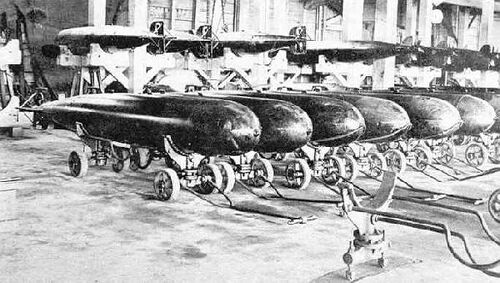
Whitehead Mk 3 torpedoes stored at the weapons depot at Naval Station Cavite, Philippines, approximately 1910-1911. The wheeled carts allowed the quick movement of the weapons from storage to the pier. Note the newer Whitehead or Bliss Mk 5, 6, or 7 torpedoes in the racks in the upper right.
Photo in the private collection of Ric Hedman.
-
Photo NH 90188 courtesy of the NHHC.
-
U.S. Navy photo.
Navy photos of a Mk 3 weapon being loaded into the USS A-2 (Submarine No. 3) at Naval Station Cavite, Philippines, circa 1912. The sailor manhandling the weapon down the hatch gives a good sense of scale to the torpedo, and illustrates how short the mid-body was compared to later torpedoes. Our early submarines were restricted to the use of these short weapons because they were the only ones that would fit inside the boats and the tubes they used. That would quickly change.
Bliss-Leavitt Mark 4 Mod 1

D-3 hoisting aboard a Mk 4 torpedo that it as just recovered from a practice shot, circa 1912. This photo gives a good view of the aft end of the weapon, including the control surfaces and the twin contra-rotating propellers. The twin axially mounted propellers spinning in opposite directions eliminated roll torque, preventing the weapon from cork-screwing along its longitudinal axis. Eliminating the roll torque also allowed the gyro to maintain a more accurate course. Note the two very small rudders mounted in cutouts in the upper and lower skeg. The depth control planes were larger but mounted in a similar fashion. The rudder and planes skegs continue aft and form a + shaped guard around the propellers that is attached to the very aft end of the weapon. This was done out of concern that the torpedo's aft end may strike the edge of the tube while exiting and damage the control surfaces and the props.
U.S. Navy photo.
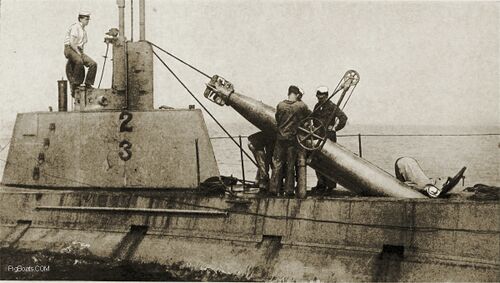
Another view of the operation shown above. There is a snubbing line attached to the aft end of the weapon, looped around the #1 periscope. This line allowed the weapon to be gently and carefully lowered into the torpedo room.
U.S. Navy photo.
Bliss-Leavitt Mark 6
Currently, PigBoats.COM does not have a good picture of a Mk 6. An idea for its appearance can be gained from the Mk 7 pictures below.
Bliss-Leavitt Mark 7
In 1922 the Navy undertook a purge of older torpedoes in an effort to simplify the supply chain and ease training issues. All torpedoes prior to the Mk 7 were recalled and removed from service. As we moved towards WWII the Mk 7 was showing its age, but it was retained so that the Navy could equip the old O-class boats that were being brought out of reserve to train new submarine crews. It was the last 18" torpedo used by the Navy.
Bliss produced four additional versions of the Mk 7 for use as aircraft dropped torpedoes. These were pulled out of service when the new Mk 13 was introduced in 1938.
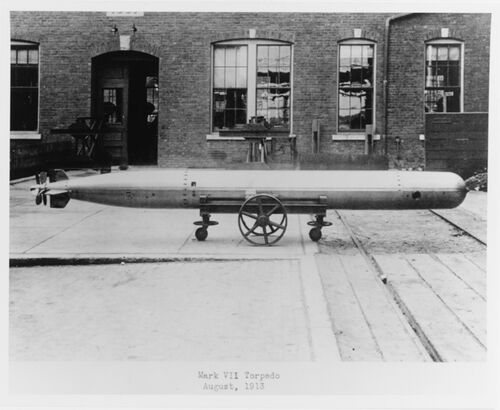
A Mk 7 torpedo on a cart at NTS Newport, August 1913. Overall, it was virtually identical to the Mk 6 in appearance, but it was equipped the the more powerful wet-heater engine. Note the control surfaces forward of the twin contra-rotating propellers. It was a good weapon, but was considered to have an underpowered warhead at only 205 lbs of TNT.
Photo courtesy of the NHHC.
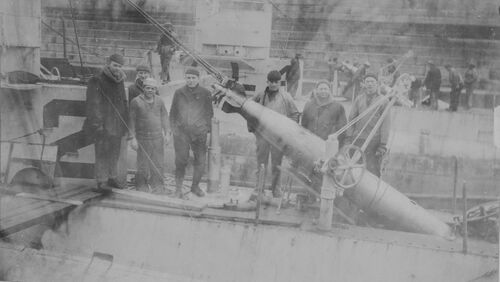
Mk 7's being loaded onto the L-2 (Submarine No. 41) and L-4 (Submarine No. 43) while in drydock in Bantry Bay Ireland, 1918. The weapon is on the skid and a snubbing line is noosed around the tail. The snubbing line is wrapped around #1 periscope, using the scope as a block to assist lowering the weapon into the torpedo room. The crewman in the peacoat and watch cap right at the aft end of the torpedo is standing on the retracted 3"/23 caliber Mk 9 deck gun.
Photo courtesy of NARA and Navsource.
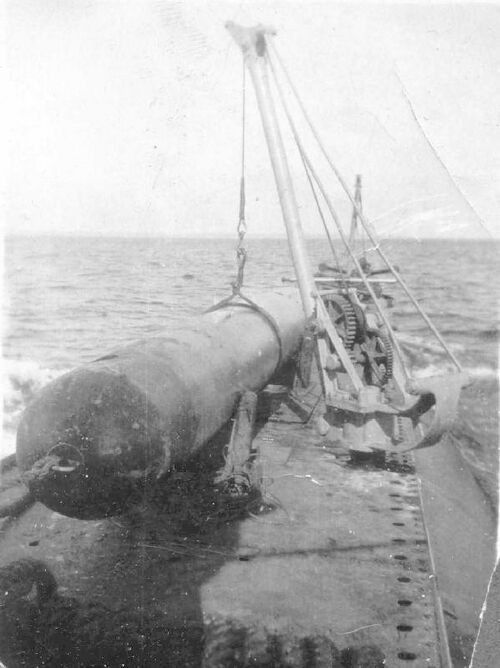
K-5 (Submarine No. 36) with a retrieved Mk 7 exercise shot on deck, early 1920's. The explosive warhead has been removed and a water filled inert warhead has replaced it. Torpedoes were very expensive, so there was a great deal of emphasis on retrieving them and reusing them after a peacetime training exercise. At the end of the run, the remaining air in the weapon's air flask would be used to blow the water out of the practice warhead, allowing the weapon to float so that it could be retrieved by the boat that fired it. It only took a half-hour or so to replace the practice head with the real thing if needed.
Photo in the private collection of Ric Hedman.
Bliss-Leavitt Mark 9 Mod 1B
Shortly after its introduction, the Navy made the tactical decision to discontinue torpedo use on battleships, moving that mission to cruisers and destroyers. The short Mk 9 was ideally suited for submarine use and thus it was modified (Mod 1B) for that new platform. The submarines of the R-class and S-class were in part designed around these weapons and the follow-on Mk 10.
The numbers built were relatively low, as it was supplanted by the Mk 10 with its bigger warhead. The Mk 9 proved to be the swan-song of the E.W. Bliss Company. When production ceased on it in 1920 the Navy awarded no further contracts to Bliss, preferring to consolidate all torpedo production at NTS Newport. The Mk 9, however, was a good weapon and it stayed in the Navy's inventory as a means to supplement the Mk 10. Mk 9's were known to be in the Philippines at the start of World War II in 1941, and some made it to the resupply inventory at Dutch Harbor in the Aleutians, and they were used in combat by the S-boats in those theaters. As far as can be determined, the Mk 9 Mod 1B stayed in Navy use until the end of the war to equip R and S-class submarines stateside, but it is doubtful that they were used in combat in the western Pacific theater much past mid 1942. Once production numbers caught up the Mk 10 was preferred due to its much more powerful warhead.

A Mk 9 Mod 1B torpedo being swung over to the USS S-34 (SS-139) at Naval Operating Base Dutch Harbor, AK, May 14, 1942. The blunt nose of this weapon is apparent here. Another reload is waiting on a cart to the left. A poorly managed industrial base stateside lead to torpedo shortages early in the war and thus the Mk 9's were thrown into action to supplement the Mk 10's until production caught up.
NARA Photo # 80-G-14096 via Navsource.
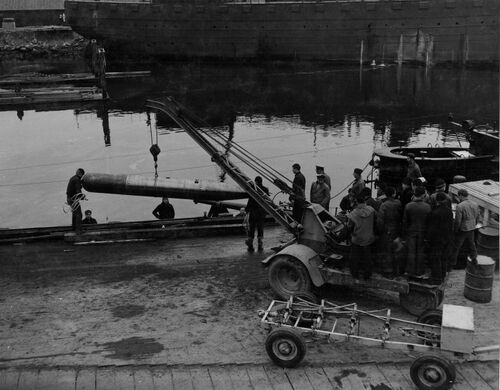
Another view of the scene above. Two lines of bolts run the circumference of the weapon, dividing it into three sections. On the left is the warhead and exploder, the middle contains the high pressure air flask and alcohol tank, and on the right is the engine, control surfaces, and propellers. For practice firings, the warhead could be replaced with an exercise head that contained an inert calcium chlorite mixture that simulated the weight of the warhead. Changing the nose was relatively easy and would take less than an hour.
NARA Photo # 80-G-14098 via Navsource.
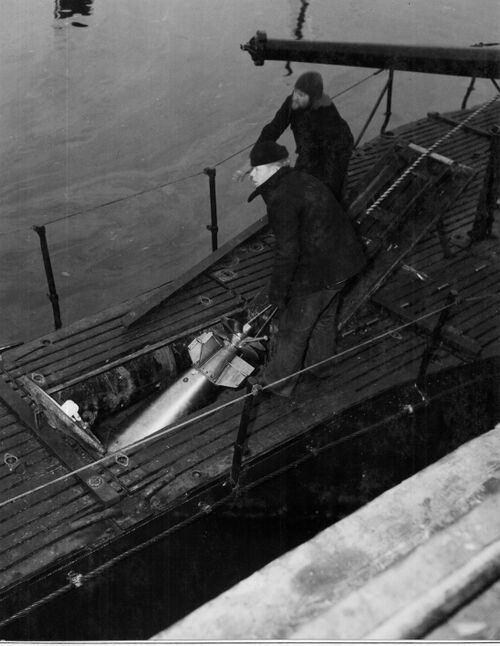
A Mk 9 torpedo being gingerly lowered into the torpedo room of S-34 while at Dutch Harbor, AK, May 14, 1942. The weapon is being lowered down the inclined loading skid through the loading hatch. A snubbing line attached to the aft end controls the rate of descent. This photo gives a good view of the aft end of the torpedo, with the rudder and depth control planes visible, along with the twin contra-rotating propellers. The vertical rudders are actually quite small, as they were used once to turn the weapon onto its preprogrammed course, then to make minor adjustments to keep the weapon on course based on inputs from the very accurate gyroscope, essentially running straight to the impact point.
However, The pressure sensors used to keep the torpedo on the set depth were still a developing technology and were far less precise than gyroscopes. Because of that the torpedo needed more control authority to keep depth. In actuality, most torpedoes of this era tended to run towards their target in an up and down "sine-wave", deviating above and below its set depth by as much as 2-4 feet. This dictated the much larger depth control planes to help dampen this sine-wave out.
NARA Photo # 80-G-14097 via Navsource.
Bliss-Leavitt/BuOrd Mark 10 Mod 3
The initial Mod 0 version of the weapon was quite similar to the Mk 9, although it had a slightly more tapered shape to the warhead section. It had a shorter range than the Mk 9, but was slightly faster. Still not satisfied with the size of the warhead, NTS personnel tinkered with the design, eventually settling on the Mod 3 version with its warhead of 497 lbs of TNT, the most powerful torpedo warhead for the USN up to that time. The speed was also increased to 36 knots, but at the sacrifice of range, which fell to 3500 yards.
A stunted testing program in the 1920's and 30's failed to reveal a depth keeping problem with this weapon. Testing in 1942 showed that it tended to run four feet deeper than set, leading to a large number of misses during the first six months of the war. For some inexplicable reason, the fact that the water filled exercise warhead weighed less than the TNT warhead had been missed, and the depth setting mechanism was calibrated based on the data received from a few test runs using the exercise head. No actual end-to-end runs with a detonation of the explosive head were ever run. Thus, once the war started and the S-boats started firing warshots they were missing at an alarming rate. Only the tendency of the weapon to run in a shallow up and down sine-wave through the water resulted in detonation hits. Once this problem was discovered it was a simple fix to correct the issue, and the Mk 10 overall turned in excellent service during the war. The S-44 (SS-155) got three Mk 10 hits on the heavy cruiser HIJMS Kako in 1942. The cruiser sank in minutes.
The introduction of Torpex explosive (40% TNT, 18% powdered aluminum, 42% RDX) in 1942 gave the Mk 10 and other torpedoes "one hell of a wallop". The increased power of Torpex actually enabled a reduction in the weight of the warhead to 485 lbs.
In the early months of WWII, one of the problems facing the Submarine Service was a lack of torpedoes. For various reasons (none good) the Mk 14 torpedoes used by the fleet submarines were in short supply. On several occasions fleet boats went out on patrol carrying Mk 10 torpedoes to supplement the short-stocked Mk 14's.
Use of the Mk 10 in combat wound down in 1944 as the S-boats were pulled from active war patrols and sent back stateside to perform less dangerous but still vital training missions. The weapon continued to serve the U.S. Navy well until the end of the war.
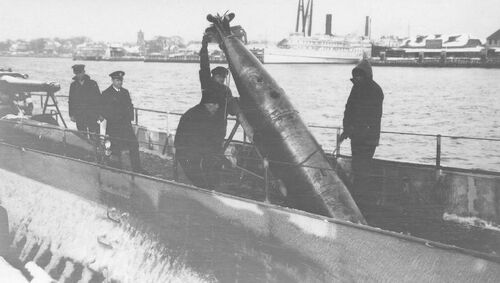
A Mk 10 slowly sliding down the loading skid of the USS S-48 (SS-159), December 1928. Instead of a snubbing line attached to the aft end of the weapon, a line and pulley system is attached to the nose of the torpedo, with a man on each side of the skid controlling its descent.
Photo in the private collection of Ric Hedman.
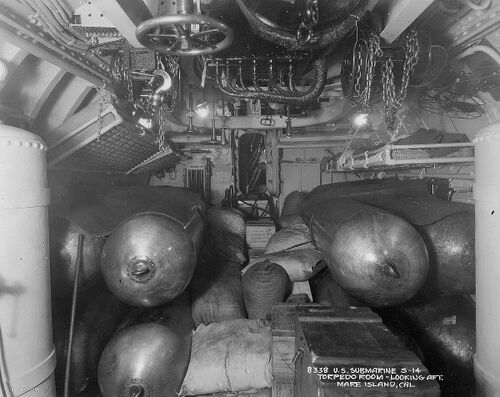
The eight Mk 10 reloads for the S-14 (SS-119) are shown stowed in her torpedo room in January 1928. The padeye on the nose of the weapon indicates that these are all exercise heads. Stores for a long trip from Mare Island down to Coco Solo, Panama are stashed in and amongst the weapons.
USN photo #8338 via NHHC.
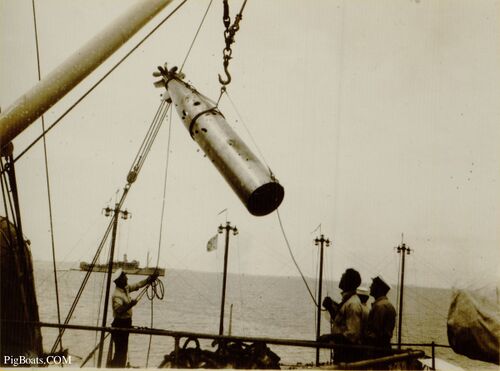
A Mk 10 minus its warhead is being hoisted aboard the S-31 (SS-136) from the tender Beaver (AS-5), approximately 1927. Once the weapon was aboard, it would take the crew less than an hour to attach either a warhead or an exercise head.
Photo in the private collection of Ric Hedman.
BuOrd Mark 14
The submarine version would be designated the Mk 14. At 20' 6" long it was far too long to be used by the S-boats, but perfectly sized for the new fleet submarines then being built. The longer length gave it a much longer range and a advanced wet-heater steam turbine engine gave a stunning speed of up to 46 knots. It also had a brand new feature: a dual speed setting. If set to the lower speed setting of 31 knots it had a range of 9000 yards. At the higher speed the range was 4500 yards.
One of the features of the Mk 14 was the brand new and top-secret Mk 6 exploder mechanism. This exploder was designed to sense the magnetic field of the target and detonate the warhead as the torpedo passed directly under the keel. Ships did not carry armor in this location and the concept of incompressibility of water meant that these types of detonations would have a devastating effect.
The Mk 14 was produced solely at NTS Newport. It was a very intricate and finely crafted piece of machinery, literally hand crafted one-by-one. In theory it gave the operating forces a tremendous tactical advantage and the staff of Newport and the Bureau of Ordnance were justifiably proud of the "wonder weapon" that they had produced.
However, this weapon came along as the nation was wallowing in the depths of the Great Depression. Thus the testing program was very stunted and unrealistic. Put into full production without being adequately tested the torpedo had numerous faults; they were of such a nature as to be difficult to find if not rigorously tested. Once the war started, alarming reports of torpedo malfunctions began to surface as misses began to rack up. The problems could be grouped into three major areas: deep running, erratic course keeping, and the complete failure of the Mk 6 exploder in either influence or contact mode. The leaders of the BuOrd and the technicians at NTS Newport steadfastly refused to believe anything was wrong with the weapon that they had developed. They blamed all of the faults on the operating forces and refused to do anything about it. Only when high level officers ordered field tests and put personal pressure on the Newport staff did they finally admit that there were problems. It took until the summer of 1943 before the issues with the Mk 14 were corrected. The tarnish of The Great Torpedo Scandal was finally put aside and the Mk 14 turned in fine performance afterwards, becoming responsible for several million tons of enemy shipping. For more information on the Great Torpedo Scandal and how it possibly could have been avoided, please see this link.
As it turned out, the low speed setting was rarely used. The higher speed of 46 knots turned out to be more valuable to the submarine crews than the longer range. The Mk 14 was eventually refitted with a Torpex warhead of up to 643 lbs. This gave it a potent punch. The influence feature of the Mk 6 exploder was permanently deactivated and thereafter used as a simple contact exploder.

A detailed diagram of the infamous Mk 14 torpedo. The void space around the exploder in the nose is filled with the TNT or Torpex explosive. The afterbody contained the steam engine, a finely craft work of mechanical art fit into a very small space.
USN image courtesy of Wikipedia
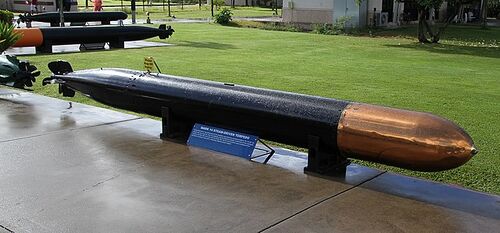
A Mk 14 torpedo on display at the Pacific Fleet Submarine Museum, Pearl Harbor Hawaii. The actual colors of the weapon varied considerably. The shiny brass head on this particular display is likely an exercise head shined for display purposes.
Photo courtesy of the Pacific Fleet Submarine Museum.
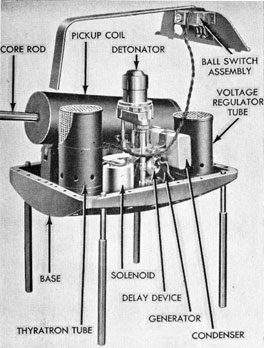
The damnable Mk 6 exploder. Developed in great secrecy in the 1930's, it was intended to detonate the warhead of the Mk 14 as it passed under the keel of the target, sensing the magnetic shift caused by the steel hull of the vessel. The resulting detonation was aided by the incompressibility of water, which forced the blast upward, breaking the keel of the ship, in theory. The problem was that the science of Earth's magnetic fields was still developing at the time and not fully understood. The fields varied considerably depending on where you were located on Earth, on what course the target was steaming, and on what angle the torpedo encountered the target. If the weapon did not pass closely enough under the keel the detonator would not trip, and if it encountered the magnetic field too far from the ship it would set off the warhead prematurely.
Supremely frustrated by the near total failure of this mechanism, submarine force commanders ordered the influence portion of the exploder to be deactivated and the weapon set to impact the vessel directly. This lead to another problem: duds.
As a backup, the Mk 6 was equipped with a contact exploder (seen in the center) that would set off the warhead if the weapon physically contacted the target. The contact portion was set vertically to the axis of travel, requiring the firing pin to travel upwards to set off the fulminate detonator. The weapon, traveling at 46 knots, struck the target at over 500 times the force of gravity and the firing pin had enough mass that the G-forces pushed it against the guide studs, preventing it from traveling far enough to set off the detonator cap! This would result in a dud.
Testing during wartime laid out all of these bugs and eventually they were eventually fixed, but not until 1943. The magnetic feature was discarded completely, and the contact portion eventually became quite reliable. But, it begs the question of what could have been accomplished if the god-cursed Mk 6 had worked the way it was supposed to from the start...
Image from U.S. Navy publication OP 635, dated 1945.
Westinghouse Mark 18 Mod 1 & Mod 2
Several German G7e electric torpedoes that missed their targets off the American east coast washed ashore in 1942 and they were turned over to BuOrd for study. The Chief of Naval Operations, Admiral Earnest King, prodded BuOrd to get Newport going quickly on a project to copy the weapons. Lacking the production capacity since they were heavily involved in the production of Mk 13, 14, and 15 torpedoes, BuOrd turned the project over to Westinghouse, and working with sub-contractor Exide the company quickly produced a copy that was rushed into production.
Very soon after introduction to the fleet the much hoped for wakeless torpedo showed some serious problems. The batteries that provided power to the motor varied in voltage with a change in outside water temperature; i.e. cold water slowed the torpedo down, sometimes considerably. The batteries also gassed excessively while being charged, giving off potentially explosive hydrogen gas. The hydrodynamic characteristics upon leaving the tube were unfavorable, causing the weapon to sometimes strike the outer edge of the tube, damaging the rudders and depth control planes. This could result in erratic course keeping and potentially to jamming of the rudder and causing a circular run. A circular run of a Mk 18 sank the famous Tang (SS-306) and almost certainly was the cause of the loss of the Tullibee (SS-284) Quality control problems at Westinghouse and Exide furthered the issues and submariners became frustrated with the weapon.
The initial Mod 1 version was supplanted by the Mod 2. Both versions were nearly identical in performance, but the Mod 2 had a relocated charging port and improvements that made the batteries far less gassy during charging.
Most of the issues were quickly eliminated, and by mid 1944 the Mk 18 came into widespread use. The wakelessness thrilled the submariners who believed it to be a significant tactical advantage. Surprisingly, post-war studies failed to bear out this belief. It was found that conventional torpedoes like the Mk 10 and Mk 14 were 17% more likely to hit a merchantman, and a whopping 250% more likely to hit an escort. The most probable cause of this disparity was the higher speed of the Mk 14, which gave the target much less time to react. It was also found that the wake left by the Mk 14 was not as visible as first thought, resulting in the target sighting the inbound weapons too late to react. Most of the fear of sighting the wake of an inbound torpedo came from exercises in the interwar years, which invariably were done in daylight and very good weather and visibility conditions. Real world wartime conditions were usually quite different. By 1945 65% of all torpedoes fired by USN submarines were Mk 18's, and overall they achieved a hit rate of 28%.
The Mk 18 was quickly eclipsed by the rapidly evolving technology of the post war period, and they were withdrawn from service in 1950.

A diagram of the Mk 18 electric torpedo. The warhead section was quite similar to the Mk 14, but the mid-body and motor section were vastly different. A row of multi-cell batteries replaced the air flask and alcohol tank, and a high-speed electric motor replaced the wet heater steam engine. The motor, set horizontally in the after-body, actually greatly simplified the drive train over the Mk 14.
An electric wakeless torpedo was a tremendous tactical advantage in certain conditions, and it would have been interesting to see what may have come if development had not been stalled in the 1920's and 30's.
Diagram from USN Ordnance Pamphlet No. 946, dated April 1943.

A Mk 18 Mod 2 torpedo shown approximately 1945. The electric motor which drove the propulsion train was known to spark and overheat. This was mostly due to the high power of the motor in such a small package. It was considered an acceptable risk as the motor only had to last as long as it took for the weapon to reach the target.
Photo NH 84498 courtesy of NHHC.
BuOrd Mark 23
Ironically, the changing tactical situation, i.e. the very success of the submarine service in sinking Japanese shipping along with better and more alert anti-submarine forces, forced a change in tactics necessitating firing from longer ranges. The Mk 14 with its 31 knot/9000 yard range capability along with the electric Mk 18 became the preferred weapons and the Mk 23 saw only limited service. Many of them were actually converted to Mk 14's and the remainder were scrapped shortly after the war ended. Some of the Salmon/Sargo-class and the Tambor/Gar-class boats of the Pigboat era fired Mk 23's in the closing months of the war.
No photo is shown as they were identical in external appearance to the Mk 14.
Page created by:
Ric Hedman & David Johnston
1999 - 2023 - PigBoats.COM©
Mountlake Terrace, WA, Norfolk, VA
webmaster@pigboats.com

